HONDA CR-V 2013 RM1, RM3, RM4 / 4.G Owners Manual
Manufacturer: HONDA, Model Year: 2013, Model line: CR-V, Model: HONDA CR-V 2013 RM1, RM3, RM4 / 4.GPages: 361, PDF Size: 6.58 MB
Page 291 of 361
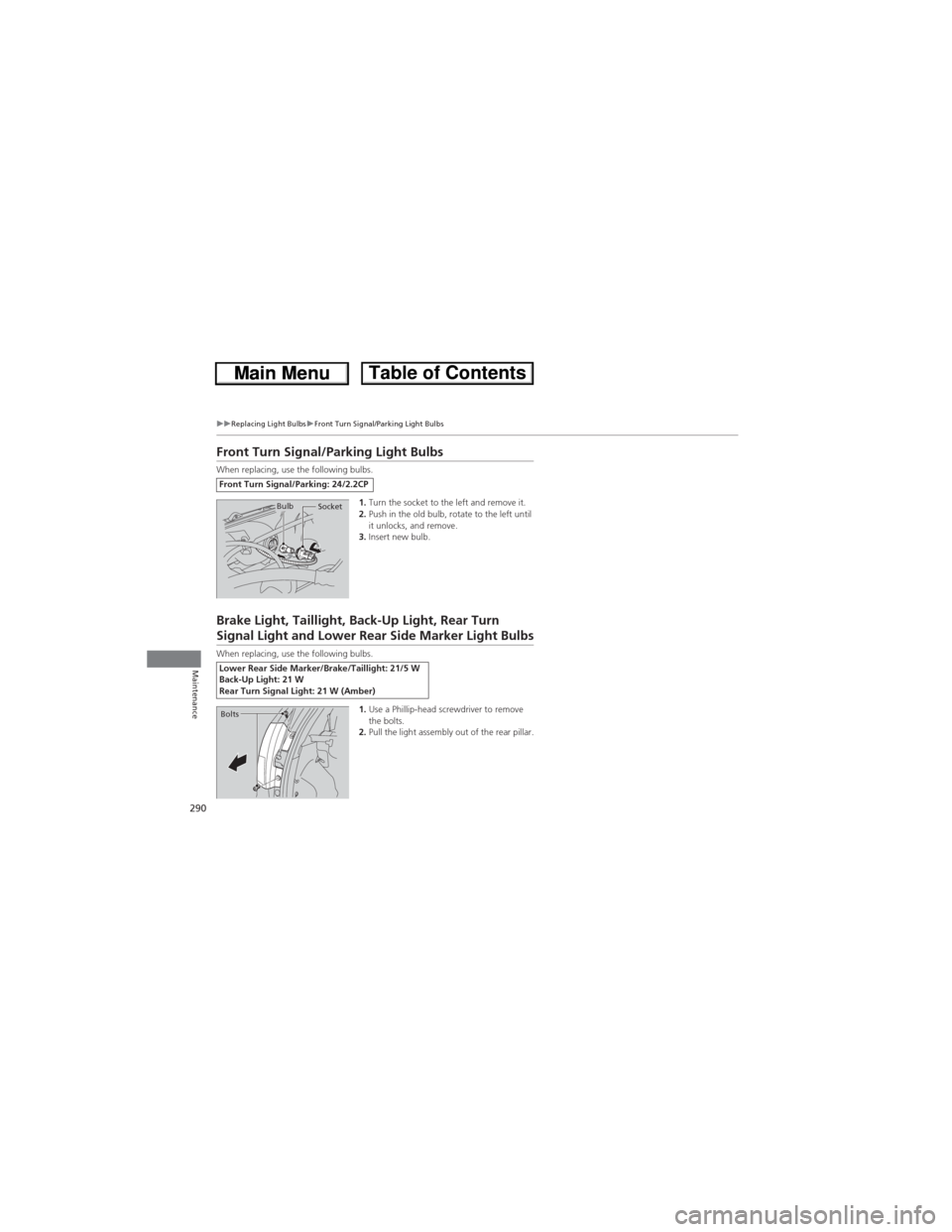
290
uuReplacing Light BulbsuFront Turn Signal/Parking Light Bulbs
Maintenance
Front Turn Signal/Parking Light Bulbs
When replacing, use the following bulbs.
1.Turn the socket to the left and remove it.
2.Push in the old bulb, rotate to the left until
it unlocks, and remove.
3.Insert new bulb.
Brake Light, Taillight, Back-Up Light, Rear Turn Signal Light and Lower Rear Side Marker Light Bulbs
When replacing, use the following bulbs.
1.Use a Phillip-head screwdriver to remove
the bolts.
2.Pull the light assembly out of the rear pillar.
Front Turn Signal/Parking: 24/2.2CP
Bulb
Socket
Lower Rear Side Marker/Brake/Taillight: 21/5 W
Back-Up Light: 21 W
Rear Turn Signal Light: 21 W (Amber)
Bolts
Page 292 of 361
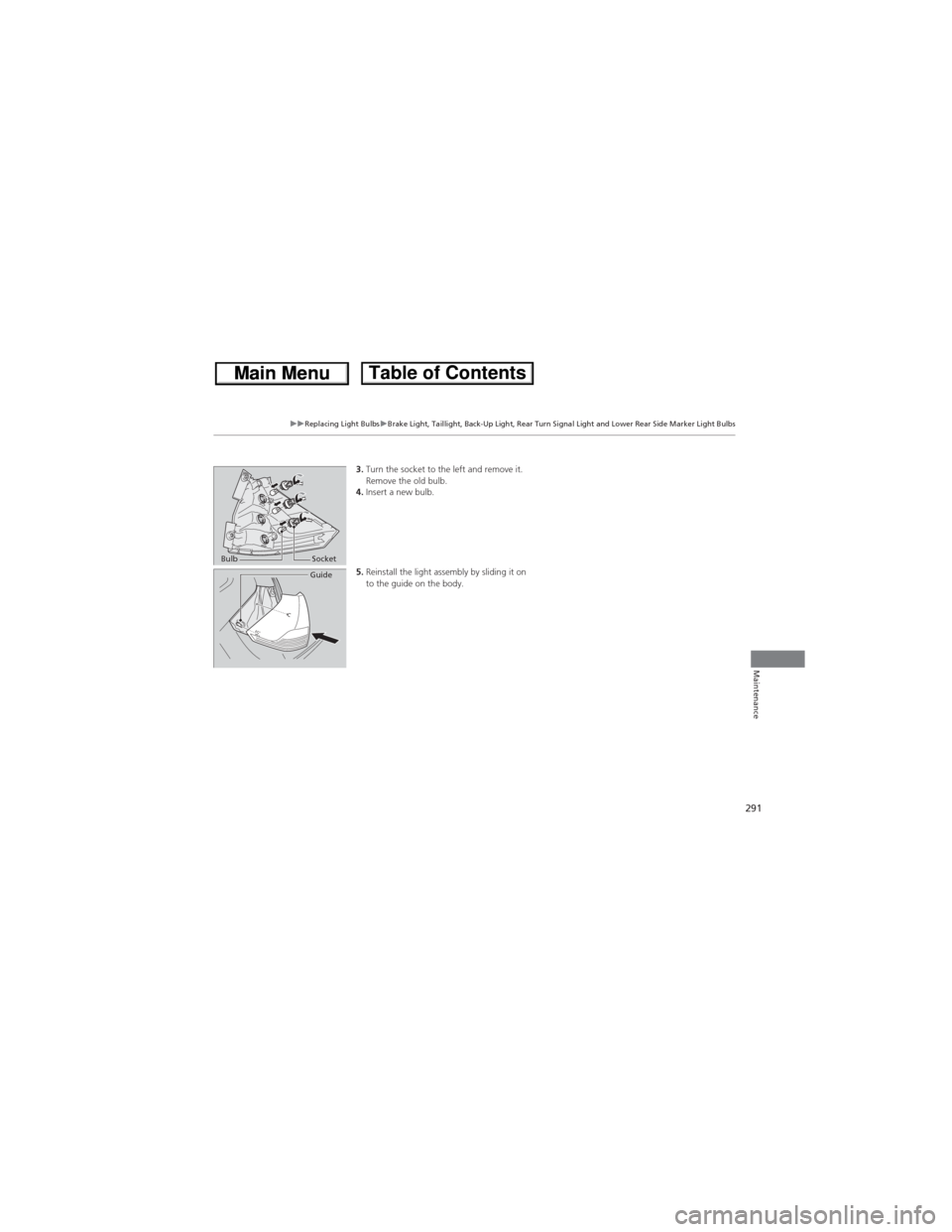
291
uuReplacing Light BulbsuBrake Light, Taillight, Back-Up Light, Rear Turn Signal Light and Lower Rear Side Marker Light Bulbs
Maintenance
3.Turn the socket to the left and remove it.
Remove the old bulb.
4.Insert a new bulb.
5.Reinstall the light assembly by sliding it on
to the guide on the body.
BulbSocket
Guide
Page 293 of 361
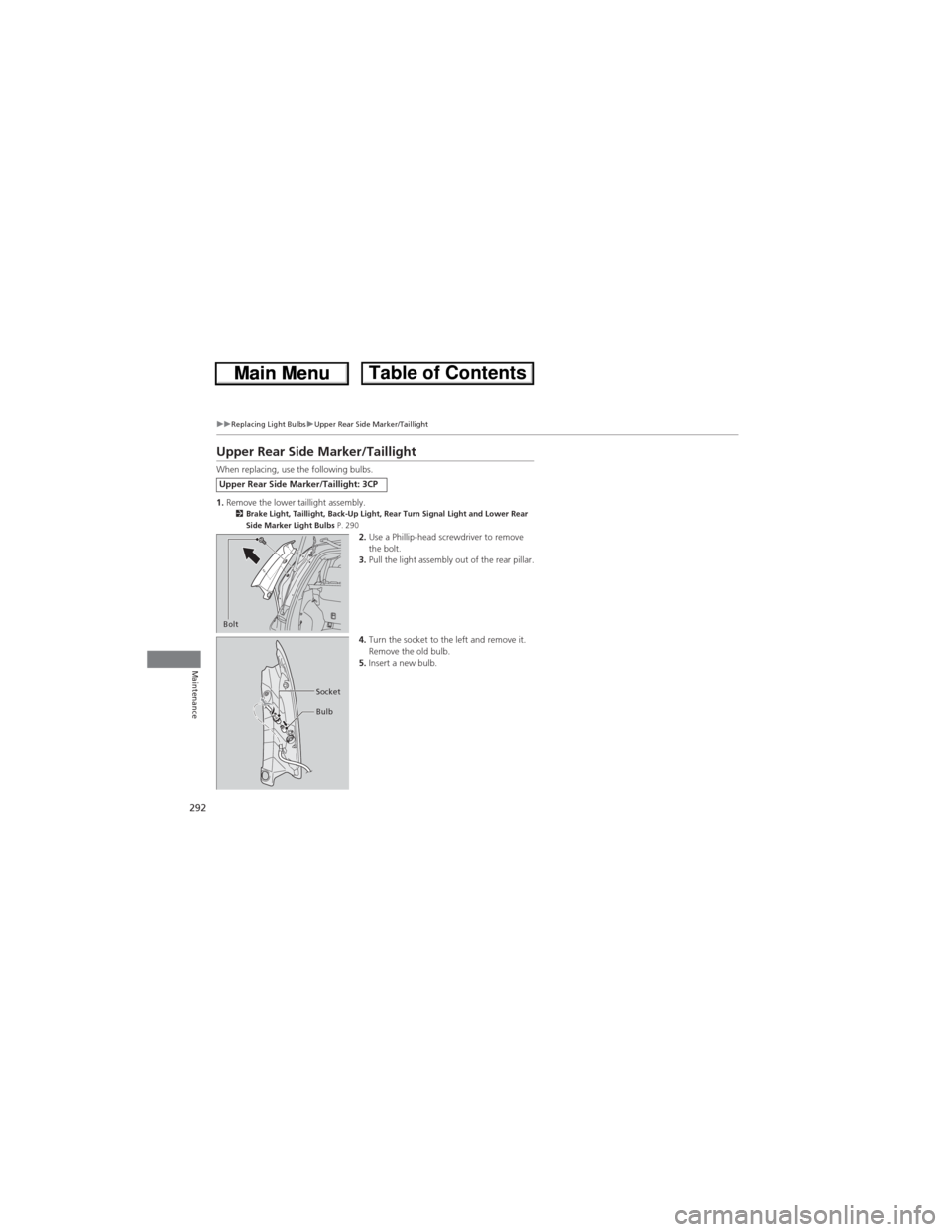
292
uuReplacing Light BulbsuUpper Rear Side Marker/Taillight
Maintenance
Upper Rear Side Marker/Taillight
When replacing, use the following bulbs.
1.Remove the lower taillight assembly.
2Brake Light, Taillight, Back-Up Light, Rear Turn Signal Light and Lower Rear
Side Marker Light Bulbs P. 290
2.Use a Phillip-head screwdriver to remove
the bolt.
3.Pull the light assembly out of the rear pillar.
4.Turn the socket to the left and remove it.
Remove the old bulb.
5.Insert a new bulb.
Upper Rear Side Marker/Taillight: 3CP
Bolt
Bulb Socket
Page 294 of 361
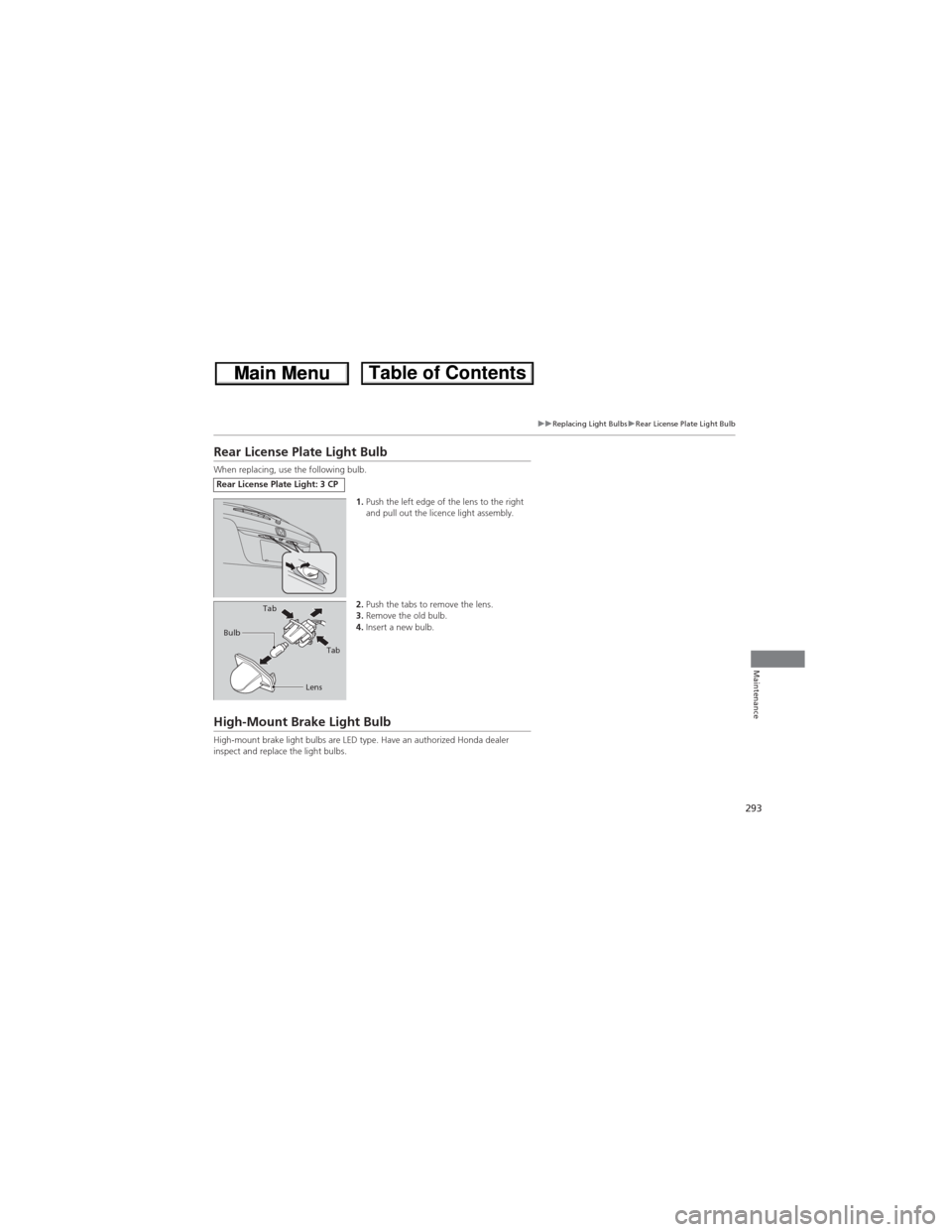
293
uuReplacing Light BulbsuRear License Plate Light Bulb
Maintenance
Rear License Plate Light Bulb
When replacing, use the following bulb.
1.Push the left edge of the lens to the right
and pull out the licence light assembly.
2.Push the tabs to remove the lens.
3.Remove the old bulb.
4.Insert a new bulb.
High-Mount Brake Light Bulb
High-mount brake light bulbs are LED type. Have an authorized Honda dealer
inspect and replace the light bulbs.
Rear License Plate Light: 3 CP
BulbTab
Tab
Lens
Page 295 of 361
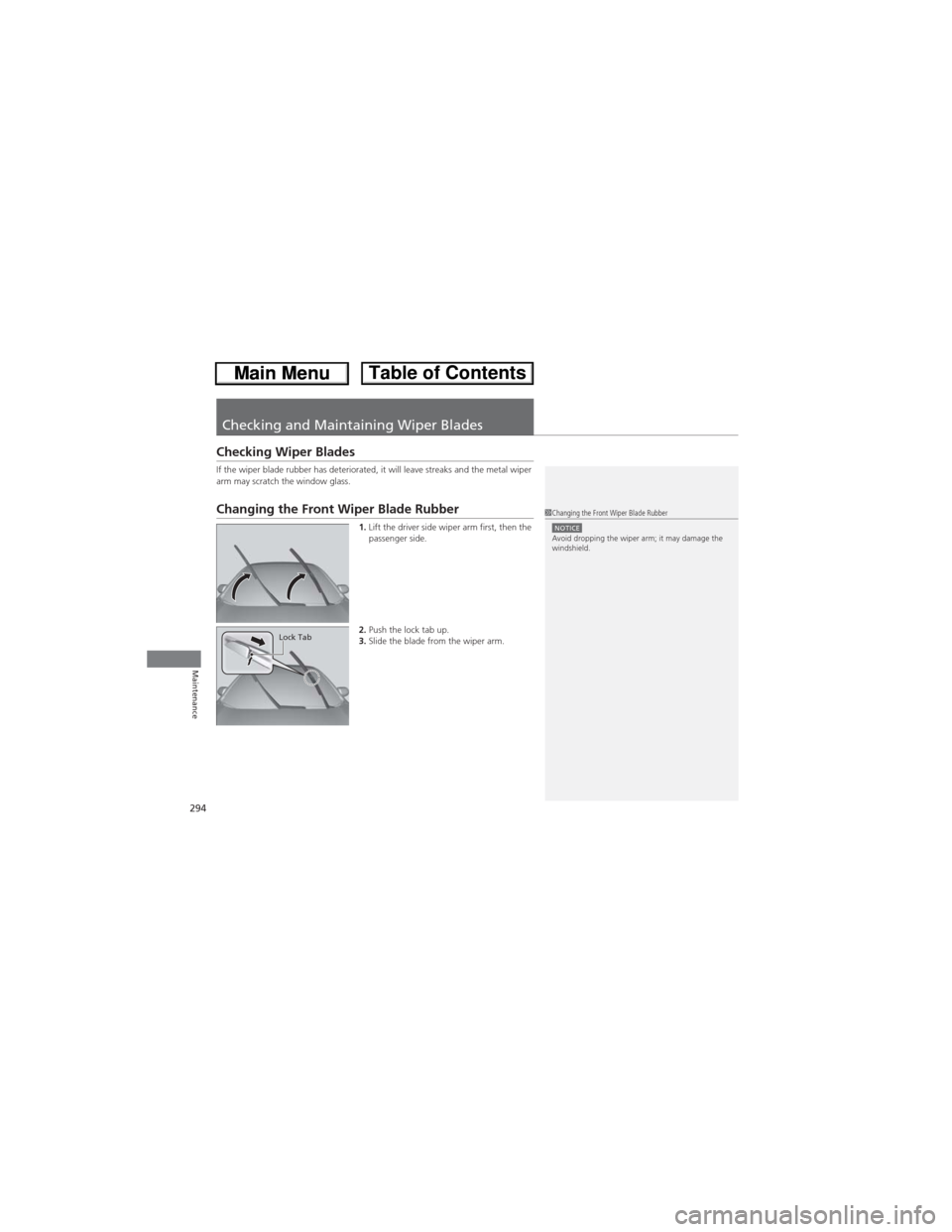
294
Maintenance
Checking and Maintaining Wiper Blades
Checking Wiper Blades
If the wiper blade rubber has deteriorated, it will leave streaks and the metal wiper
arm may scratch the window glass.
Changing the Front Wiper Blade Rubber
1.Lift the driver side wiper arm first, then the
passenger side.
2.Push the lock tab up.
3.Slide the blade from the wiper arm.1Changing the Front Wiper Blade RubberNOTICEAvoid dropping the wiper arm; it may damage the
windshield.
Lock Tab
Page 296 of 361
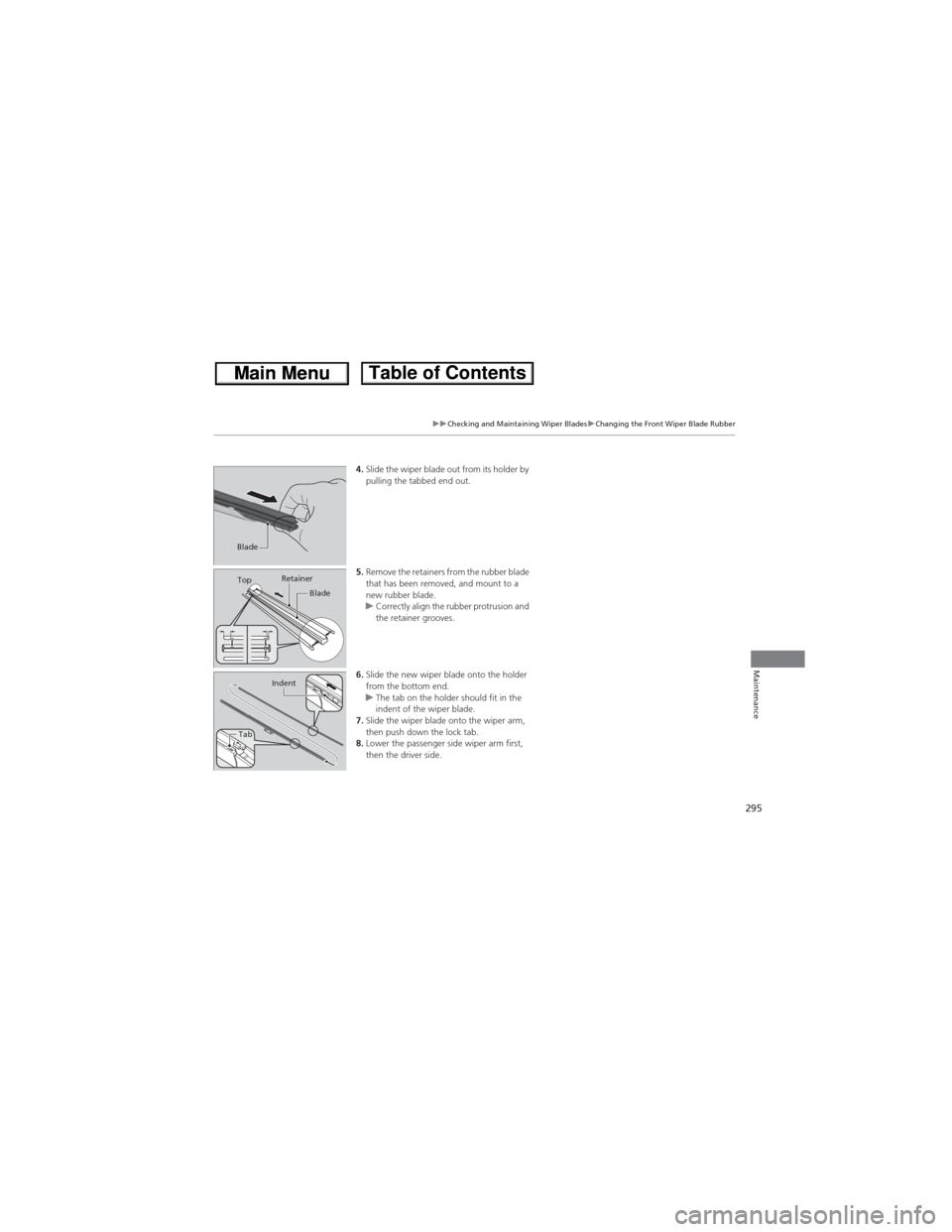
295
uuChecking and Maintaining Wiper BladesuChanging the Front Wiper Blade Rubber
Maintenance
4.Slide the wiper blade out from its holder by
pulling the tabbed end out.
5.Remove the retainers from the rubber blade
that has been removed, and mount to a
new rubber blade.
uCorrectly align the rubber protrusion and
the retainer grooves.
6.Slide the new wiper blade onto the holder
from the bottom end.
uThe tab on the holder should fit in the
indent of the wiper blade.
7.Slide the wiper blade onto the wiper arm,
then push down the lock tab.
8.Lower the passenger side wiper arm first,
then the driver side.
Blade
TopRetainer
Blade
TabIndent
Page 297 of 361
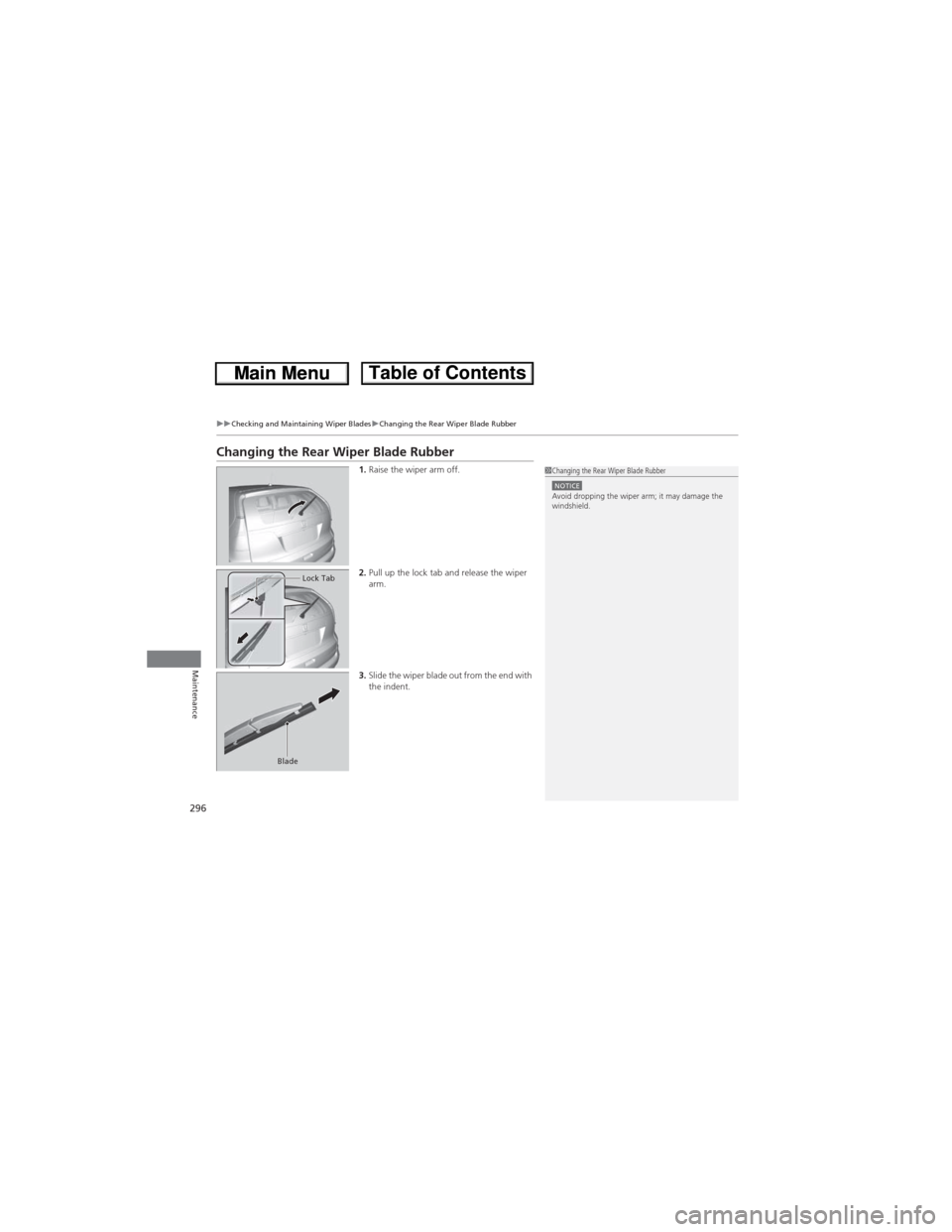
296
uuChecking and Maintaining Wiper BladesuChanging the Rear Wiper Blade Rubber
Maintenance
Changing the Rear Wiper Blade Rubber
1.Raise the wiper arm off.
2.Pull up the lock tab and release the wiper
arm.
3.Slide the wiper blade out from the end with
the indent.1Changing the Rear Wiper Blade RubberNOTICEAvoid dropping the wiper arm; it may damage the
windshield.
Lock Tab
Blade
Page 298 of 361
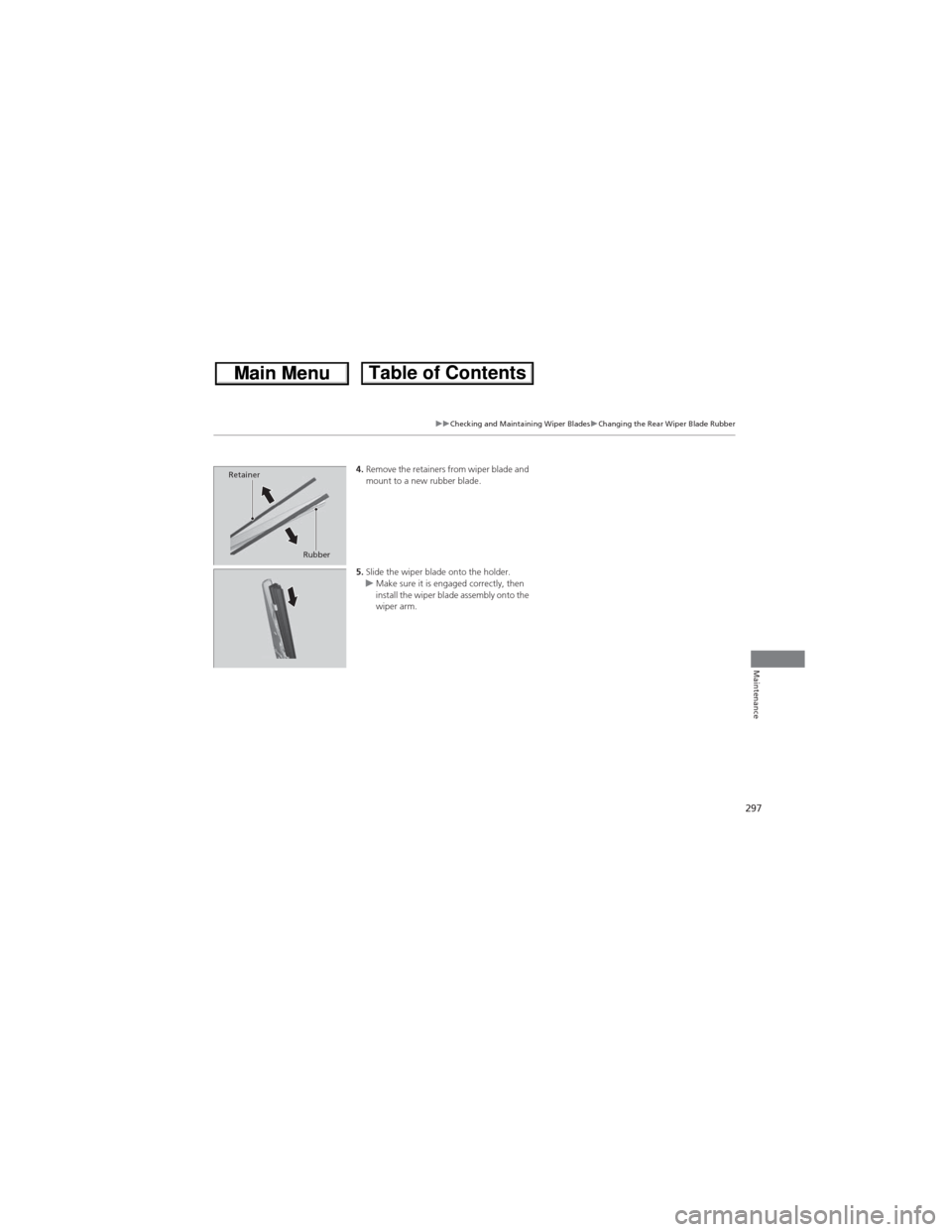
297
uuChecking and Maintaining Wiper BladesuChanging the Rear Wiper Blade Rubber
Maintenance
4.Remove the retainers from wiper blade and
mount to a new rubber blade.
5.Slide the wiper blade onto the holder.
uMake sure it is engaged correctly, then
install the wiper blade assembly onto the
wiper arm.Retainer
Rubber
Page 299 of 361
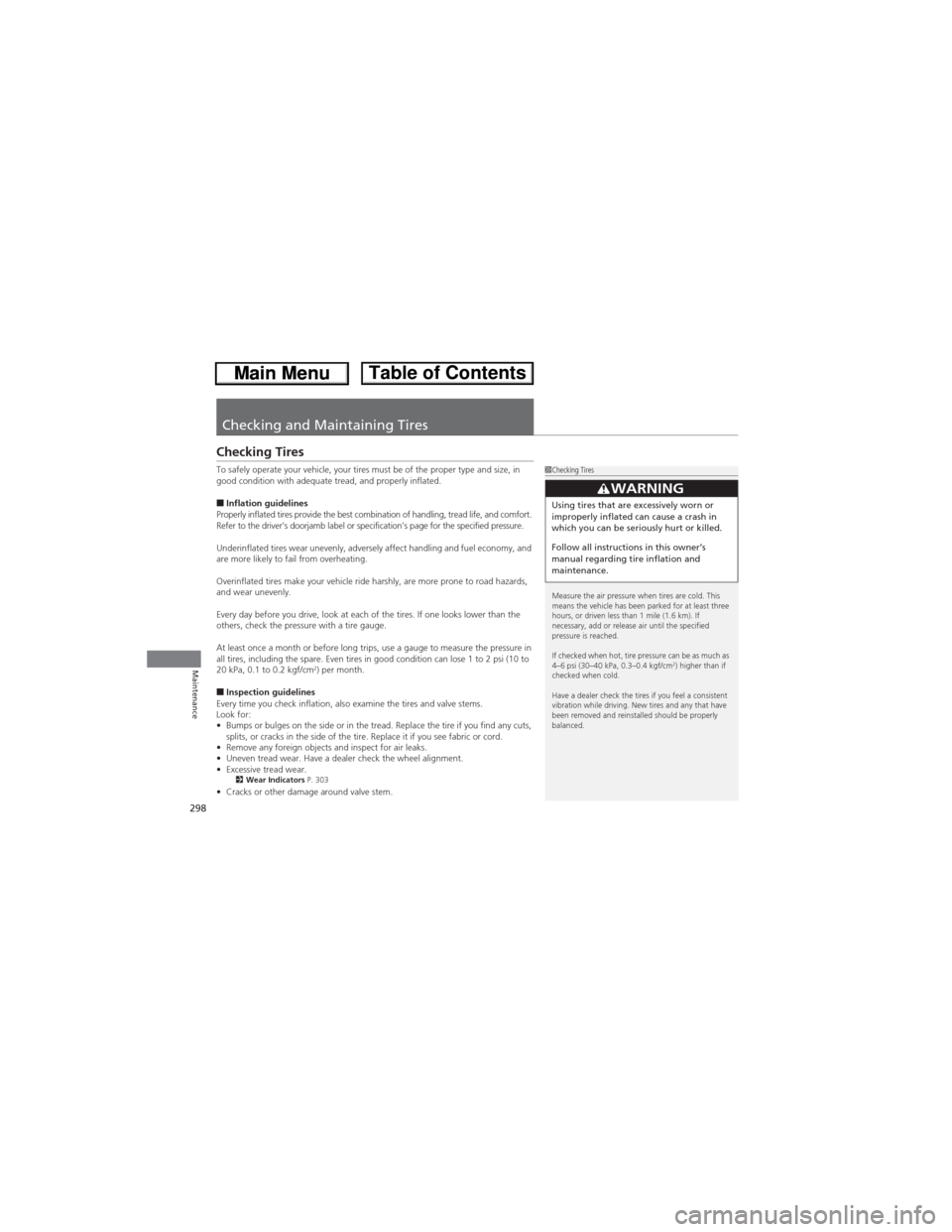
298
Maintenance
Checking and Maintaining Tires
Checking Tires
To safely operate your vehicle, your tires must be of the proper type and size, in
good condition with adequate tread, and properly inflated.
■Inflation guidelines
Properly inflated tires provide the best combination of handling, tread life, and comfort.
Refer to the driver’s doorjamb label or specification’s page for the specified pressure.
Underinflated tires wear unevenly, adversely affect handling and fuel economy, and
are more likely to fail from overheating.
Overinflated tires make your vehicle ride harshly, are more prone to road hazards,
and wear unevenly.
Every day before you drive, look at each of the tires. If one looks lower than the
others, check the pressure with a tire gauge.
At least once a month or before long trips, use a gauge to measure the pressure in
all tires, including the spare. Even tires in good condition can lose 1 to 2 psi (10 to
20 kPa, 0.1 to 0.2 kgf/cm
2) per month.
■Inspection guidelines
Every time you check inflation, also examine the tires and valve stems.
Look for:
•Bumps or bulges on the side or in the tread. Replace the tire if you find any cuts,
splits, or cracks in the side of the tire. Replace it if you see fabric or cord.
•Remove any foreign objects and inspect for air leaks.
•Uneven tread wear. Have a dealer check the wheel alignment.
•Excessive tread wear.
2Wear Indicators P. 303•Cracks or other damage around valve stem.
1Checking Tires
Measure the air pressure when tires are cold. This
means the vehicle has been parked for at least three
hours, or driven less than 1 mile (1.6 km). If
necessary, add or release air until the specified
pressure is reached.
If checked when hot, tire pressure can be as much as
4–6 psi (30–40 kPa, 0.3–0.4 kgf/cm
2) higher than if
checked when cold.
Have a dealer check the tires if you feel a consistent
vibration while driving. New tires and any that have
been removed and reinstalled should be properly
balanced.
3WARNINGUsing tires that are excessively worn or
improperly inflated can cause a crash in
which you can be seriously hurt or killed.
Follow all instructions in this owner’s
manual regarding tire inflation and
maintenance.
Page 300 of 361
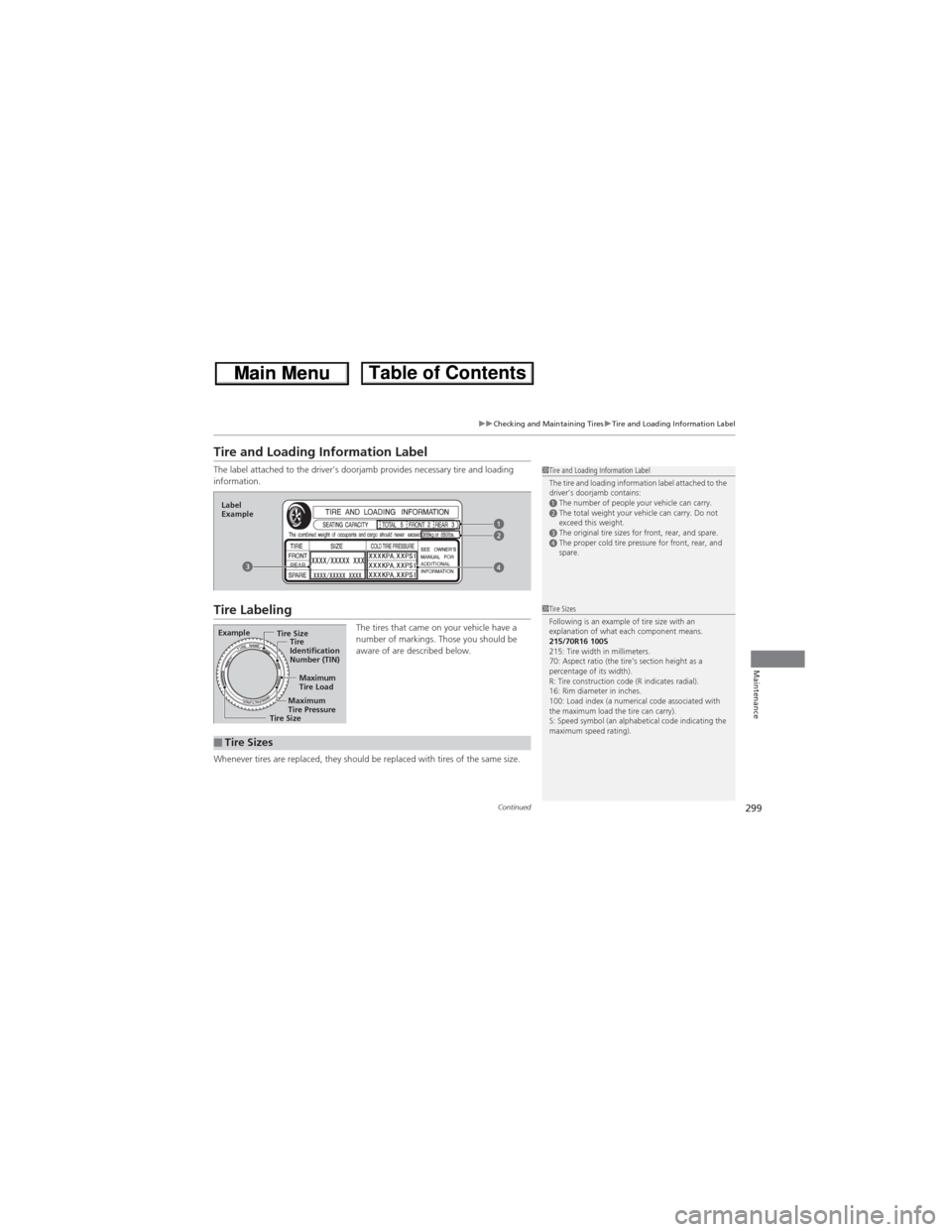
299
uuChecking and Maintaining TiresuTire and Loading Information Label
Continued
Maintenance
Tire and Loading Information Label
The label attached to the driver’s doorjamb provides necessary tire and loading
information.
Tire Labeling
The tires that came on your vehicle have a
number of markings. Those you should be
aware of are described below.
Whenever tires are replaced, they should be replaced with tires of the same size.
1Tire and Loading Information Label
The tire and loading information label attached to the
driver’s doorjamb contains:
aThe number of people your vehicle can carry.bThe total weight your vehicle can carry. Do not
exceed this weight.
cThe original tire sizes for front, rear, and spare.dThe proper cold tire pressure for front, rear, and
spare.
Label
Example
Example
Tire Size
Tire
Identification
Number (TIN)
Maximum
Tire Load
Maximum
Tire Pressure
Tire Size
■Tire Sizes
1Tire Sizes
Following is an example of tire size with an
explanation of what each component means.
215/70R16 100S
215: Tire width in millimeters.
70: Aspect ratio (the tire’s section height as a
percentage of its width).
R: Tire construction code (R indicates radial).
16: Rim diameter in inches.
100: Load index (a numerical code associated with
the maximum load the tire can carry).
S: Speed symbol (an alphabetical code indicating the
maximum speed rating).